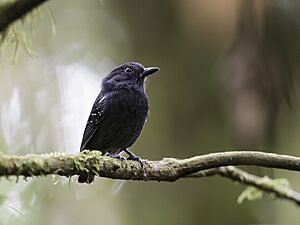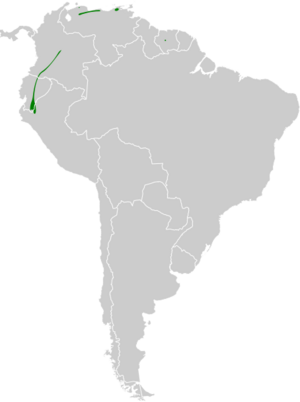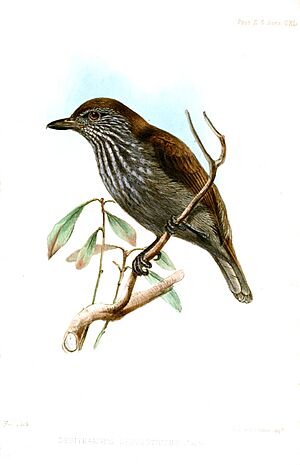White-streaked antvireo facts for kids
Quick facts for kids White-streaked antvireo |
|
|---|---|
 |
|
| Male | |
| Conservation status | |
| Scientific classification | |
| Genus: |
Dysithamnus
|
| Species: |
leucostictus
|
 |
|
The white-streaked antvireo (also called the white-spotted antvireo) is a small bird found in South America. Its scientific name is Dysithamnus leucostictus. You can find this bird in countries like Colombia, Ecuador, Peru, Suriname, and Venezuela. It belongs to a group of birds known as "typical antbirds".
Contents
About the White-Streaked Antvireo
How it Got its Name
The white-streaked antvireo was first described by a British zoologist named Philip Sclater in 1858. He gave it the scientific name Dysithamnus leucostictus. The second part of its name, leucostictus, comes from two old Greek words: leukos meaning "white" and stiktos meaning "spotted". This name perfectly describes the bird's appearance!
There are two slightly different types, or subspecies, of the white-streaked antvireo. They are called D. l. leucostictus and D. l. tucuyensis.
What Does it Look Like?
The white-streaked antvireo is a small bird, about 12 to 13 centimeters (around 5 inches) long. It weighs about 20 grams, which is about as much as four nickels!
Males and Females
Adult male white-streaked antvireos of the main subspecies are mostly dark gray. They have a hidden white patch on their back, near their shoulders. Their wings are dark gray with white tips and edges. Their chest is a darker gray than their back.
Female white-streaked antvireos look quite different. They have a reddish-brown head, neck, back, wings, and tail. The sides of their head, throat, and belly are mostly gray with clear white streaks. Their lower belly and under-tail feathers have a brownish tint and no streaks.
Young Birds and Subspecies Differences
Young males are mostly gray with a reddish-brown tint. Their wings are reddish-brown, and their tail is dark brown. Their throat has pale gray spots, and their belly has thin white streaks.
The other subspecies, D. l. tucuyensis, has some differences. Males of this type have more white on their wings. Females are lighter in color, with yellower upper parts. They also have bigger streaks on their belly and olive-colored lower belly and under-tail feathers.
Where Does it Live?
The two types of white-streaked antvireos live in different areas. The main subspecies, D. l. leucostictus, lives on the eastern side of the Andes mountains. You can find it from central Colombia south through eastern Ecuador and a little bit into northern Peru.
The D. l. tucuyensis subspecies lives in the coastal mountains of Venezuela. It also has a small group living on a mountain called Tafelberg in central Suriname.
Its Home in the Forest
This bird lives in the lower parts of mountain evergreen forests. It prefers areas that are not too disturbed by people. It can be found at different heights depending on the country:
- In Colombia, it lives between 900 and 1800 meters (about 2,950 to 5,900 feet) above sea level.
- In Ecuador, it's mostly found between 1300 and 1800 meters (about 4,260 to 5,900 feet).
- In Peru, it lives between 1350 and 1850 meters (about 4,430 to 6,070 feet).
- In Venezuela, it's found between 500 and 1900 meters (about 1,640 to 6,230 feet).
- On Tafelberg in Suriname, it lives at about 1000 meters (about 3,280 feet).
How it Behaves
Movement and Daily Life
The white-streaked antvireo is thought to stay in the same area all year round. It doesn't usually migrate.
What Does it Eat?
We don't know all the details about what the white-streaked antvireo eats. But we do know it mainly eats insects and other small creatures like spiders. It usually hunts for food in pairs. Often, it joins a group of different bird species that are all looking for food together.
It typically feeds about 1.5 to 4 meters (about 5 to 13 feet) above the ground. However, it often drops to the ground to catch its prey. It finds food on live leaves, vines, and small branches by picking things off or jumping up from a perch.
Vocalization: Its Song
The song of the main subspecies sounds like a short series of strong whistles. The pitch usually falls, except sometimes for the very first note. People have described it as "wee WEE wee wee wee whew".
The song of the D. l. tucuyensis subspecies is a bit longer. It's a series of strong whistles where the pitch and loudness slowly get higher in the middle, then slowly get lower again.
Conservation Status
The International Union for Conservation of Nature (IUCN) checks on how many of these birds are left. In 2004, they said the white-streaked antvireo was of "Least Concern," meaning it wasn't in much danger. In 2012, they changed it to "Vulnerable," but then in 2020, it went back to "Least Concern."
This bird lives in a large area, but we don't know exactly how many there are. Scientists believe its numbers might be going down. The biggest problem for this bird is that its forest home is being lost. It needs forests that haven't been disturbed much. This means it's very sensitive to forests being cut down or broken into smaller pieces.
It's considered uncommon in Colombia, Ecuador, and Peru. In these countries, the forests in the Andes mountains are being cleared quickly for farms and new towns. However, in Venezuela, it can be common in some places, and it lives in several protected areas there.
Images for kids





